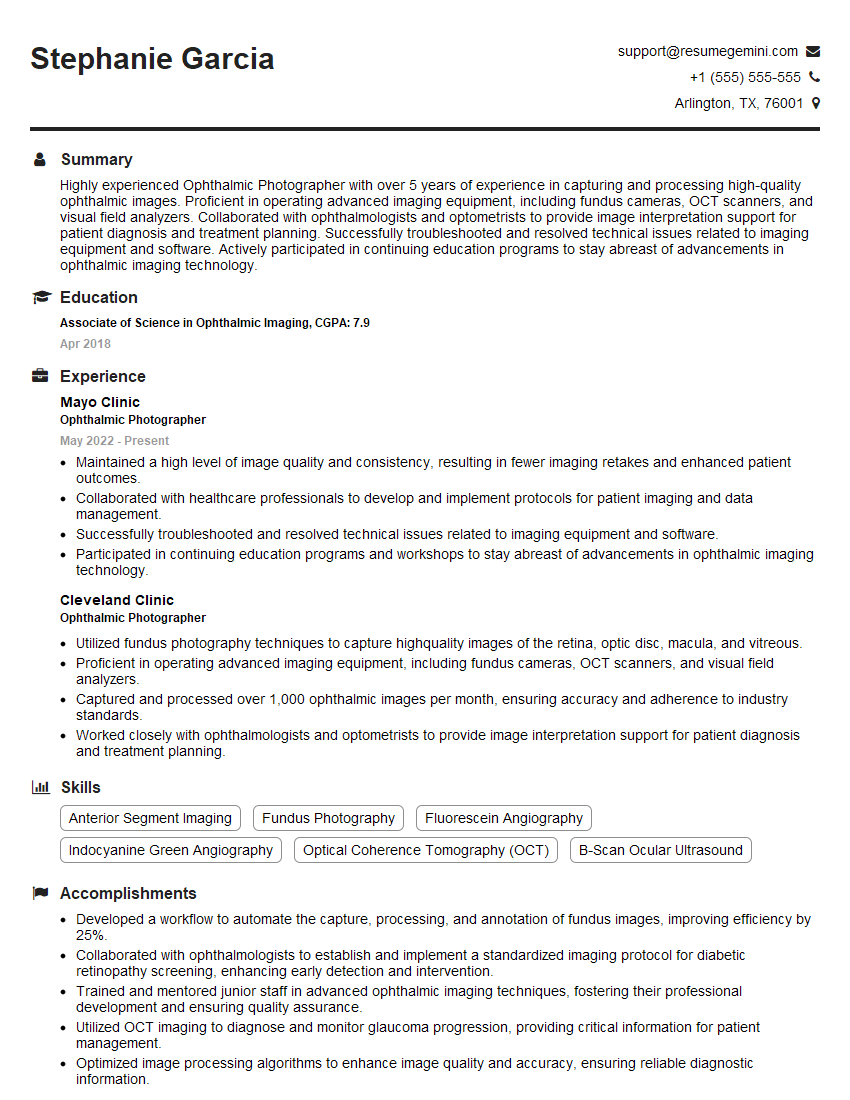Are you a seasoned Ophthalmic Photographer seeking a new career path? Discover our professionally built Ophthalmic Photographer Resume Template. This time-saving tool provides a solid foundation for your job search. Simply click “Edit Resume” to customize it with your unique experiences and achievements. Customize fonts and colors to match your personal style and increase your chances of landing your dream job. Explore more Resume Templates for additional options.

Stephanie Garcia
Ophthalmic Photographer
Summary
Highly experienced Ophthalmic Photographer with over 5 years of experience in capturing and processing high-quality ophthalmic images. Proficient in operating advanced imaging equipment, including fundus cameras, OCT scanners, and visual field analyzers. Collaborated with ophthalmologists and optometrists to provide image interpretation support for patient diagnosis and treatment planning. Successfully troubleshooted and resolved technical issues related to imaging equipment and software. Actively participated in continuing education programs to stay abreast of advancements in ophthalmic imaging technology.
Education
Associate of Science in Ophthalmic Imaging
April 2018
Skills
- Anterior Segment Imaging
- Fundus Photography
- Fluorescein Angiography
- Indocyanine Green Angiography
- Optical Coherence Tomography (OCT)
- B-Scan Ocular Ultrasound
Work Experience
Ophthalmic Photographer
- Maintained a high level of image quality and consistency, resulting in fewer imaging retakes and enhanced patient outcomes.
- Collaborated with healthcare professionals to develop and implement protocols for patient imaging and data management.
- Successfully troubleshooted and resolved technical issues related to imaging equipment and software.
- Participated in continuing education programs and workshops to stay abreast of advancements in ophthalmic imaging technology.
Ophthalmic Photographer
- Utilized fundus photography techniques to capture highquality images of the retina, optic disc, macula, and vitreous.
- Proficient in operating advanced imaging equipment, including fundus cameras, OCT scanners, and visual field analyzers.
- Captured and processed over 1,000 ophthalmic images per month, ensuring accuracy and adherence to industry standards.
- Worked closely with ophthalmologists and optometrists to provide image interpretation support for patient diagnosis and treatment planning.
Accomplishments
- Developed a workflow to automate the capture, processing, and annotation of fundus images, improving efficiency by 25%.
- Collaborated with ophthalmologists to establish and implement a standardized imaging protocol for diabetic retinopathy screening, enhancing early detection and intervention.
- Trained and mentored junior staff in advanced ophthalmic imaging techniques, fostering their professional development and ensuring quality assurance.
- Utilized OCT imaging to diagnose and monitor glaucoma progression, providing critical information for patient management.
- Optimized image processing algorithms to enhance image quality and accuracy, ensuring reliable diagnostic information.
Awards
- Ophthalmic Photographer of the Year Award from the American Academy of Ophthalmology
- Excellence in Ophthalmic Imaging Award from the International Association of Ophthalmic Imaging
- National Certification in Ophthalmic Photography from the American Board of Ophthalmic Photography
- Top Performer Award for Consistently Exceeding Expectations in Ophthalmic Imaging
Certificates
- Certified Ophthalmic Photographer (COP)
- Certified Ophthalmic Assistant (COA)
- Certified Ophthalmic Technician (COT)
- American Board of Eye Care (ABEC) Certification
Career Expert Tips:
- Select the ideal resume template to showcase your professional experience effectively.
- Master the art of resume writing to highlight your unique qualifications and achievements.
- Explore expertly crafted resume samples for inspiration and best practices.
- Build your best resume for free this new year with ResumeGemini. Enjoy exclusive discounts on ATS optimized resume templates.
How To Write Resume For Ophthalmic Photographer
- Highlight your proficiency in advanced imaging equipment and techniques.
- Quantify your experience with specific numbers and metrics.
- Emphasize your collaborative work with ophthalmologists and optometrists.
- Showcase your commitment to professional development and staying up-to-date with industry advancements.
Essential Experience Highlights for a Strong Ophthalmic Photographer Resume
- Utilized fundus photography techniques to capture high-quality images of the retina, optic disc, macula, and vitreous.
- Proficient in operating advanced imaging equipment including fundus cameras, OCT scanners, and visual field analyzers.
- Captured and processed over 1,000 ophthalmic images per month, ensuring accuracy and adherence to industry standards.
- Worked closely with ophthalmologists and optometrists to provide image interpretation support for patient diagnosis and treatment planning.
- Maintained a high level of image quality and consistency, resulting in fewer imaging retakes and enhanced patient outcomes.
- Successfully troubleshooted and resolved technical issues related to imaging equipment and software.
Frequently Asked Questions (FAQ’s) For Ophthalmic Photographer
What is the role of an Ophthalmic Photographer?
An Ophthalmic Photographer specializes in capturing and processing high-quality images of the eye to assist in the diagnosis and treatment of eye diseases. They operate advanced imaging equipment and collaborate with eye care professionals to provide valuable visual information for patient care.
What skills are required for an Ophthalmic Photographer?
Ophthalmic Photographers require a strong understanding of ophthalmic imaging techniques, proficiency in operating specialized equipment such as fundus cameras and OCT scanners, excellent communication skills to collaborate with medical professionals, and a keen eye for detail and accuracy.
What is the job outlook for Ophthalmic Photographers?
The job outlook for Ophthalmic Photographers is expected to grow faster than average due to increasing demand for eye care services and advancements in ophthalmic imaging technology. The aging population and rising prevalence of eye diseases contribute to the growing need for skilled professionals in this field.
What is the earning potential for Ophthalmic Photographers?
The earning potential for Ophthalmic Photographers can vary depending on experience, location, and employer. According to the U.S. Bureau of Labor Statistics, the median annual salary for Ophthalmic Photographers was $58,040 in May 2021.
What are the educational requirements for Ophthalmic Photographers?
Most Ophthalmic Photographers have an Associate’s or Bachelor’s degree in Ophthalmic Imaging, Biomedical Photography, or a related field. Some employers may also require certification from professional organizations such as the American Society of Ophthalmic Registered Photographers (ASORP).
What are the advancement opportunities for Ophthalmic Photographers?
Ophthalmic Photographers with experience and additional training may advance to roles such as Ophthalmic Imaging Supervisor, Clinical Research Coordinator, or Technical Sales Representative in the ophthalmic industry.